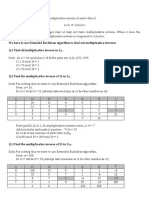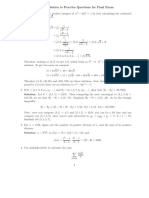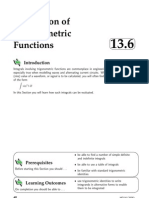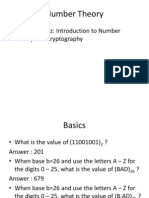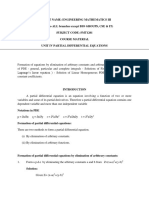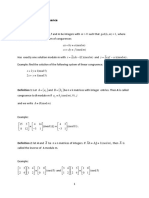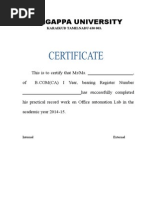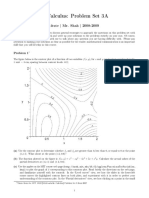Solutions To Homework 2: 1 Problem 1.14
Uploaded by
Munish MehraSolutions To Homework 2: 1 Problem 1.14
Uploaded by
Munish MehraSolutions to Homework 2
Debasish Das
EECS Department, Northwestern University
ddas@northwestern.edu
1 Problem 1.14
Using the results from 0.4, Fibonacci numbers in terms of matrix can be repre-
sented as follows
F
n
F
n+1
0 1
1 1
n
.
F
0
F
1
(1)
Since F
n
(mod p) can be obtained by taking the rst term of the matrix
F
n
F
n+1
(mod p). As the matrix
F
0
F
1
is a constant matrix, computing
0 1
1 1
n
(mod
p) is sucient to compute F
n
(mod p). We call the matrix
0 1
1 1
as A. An
extension of modular exponentiation algorithm can be employed to solve this
problem once we prove the following theorem.
Theorem 1 Given any general matrix A, (A mod p)(A mod p) = A
2
(mod p)
Proof: Assume A as any matrix
a b
c d
. (A mod p) can be written as
a + k
1
p b + k
2
p
c + k
3
p d + k
4
p
where k
1
, .., k
4
are arbitrary integers. After multiplying
(A mod p) with (A mod p), the rst term in the nal matrix can be written as
b
2
+ ac + p(C) where C is any constant which is equivalent to the rst term of
the matrix A
2
(mod p). Similarly it holds for other terms as well.
Using the above theorem, we can establish in general that (A
n
(mod p)
(A mod p) = A
n+1
(mod p). The algorithm is given as
function Modified-modexp(A, p, n)
Input: 2x2 Array A where each element is of n-bits,
p (n bit) and integer exponent n
Output: A
n
mod p
if y = 0: return I
2
z = Modified-modexp(A,p,
n
2
)
temp = (z mod p)(z mod p)
if y is even:
1
return temp
else:
return (A mod p)temp
Complexity Analysis : Number of recursive calls are analogous to Modular
Exponentiation presented at page 19. Matrix multiplication is O(n
2
) (Chapter
3 presents a better bound). Hence the complexity of the algorithm is O(n
3
).
2 Problem 1.15
Statement : For any a, b, if ax bx mod c, then a b mod c.
Necessary and Sucient Condition Derivation
ax bx(modc) c|(a b)x
a b(modc) c|(a b)
Now since c must divide (a-b)x and c must divide (a-b), we should choose x
such that GCD(c,x) = 1 which will ensure that if (a-b)x is divisible by c, then
(a-b) must be divisible by c as GCD(c,x) is 1.
3 Problem 1.17
x and y are each n-bit long. We are performing complexity analysis of 2 algo-
rithms for x
y
computation.
function Iterative-Exponentiation(x,y)
Input: x and y each n-bit long
Output: x
y
prod = x
for i = 1 to y-1
prod = x * prod
return prod
Complexity Analysis : After each multiplication, the size of the product be-
comes i.n where i is the current iteration. Total time is given by
y1
i=0
O(in n)
=
(y1)y
2
O(n
2
). The complexity is O(y
2
n
2
) where y is O(2
n
).
function Recursive-Exponentiation(x,y)
Input: x and y each n-bit long
Output: x
y
if y = 0: return 1
z = Recursive-Exponentiation(x,
y
2
)
if y is even:
return z*z
else:
return x*z*z
2
Complexity Analysis : Since y is n-bit long, the number of iterations is bounded
by O(n). Size of z on each return from recursive call increases by a factor of 4.
Total running time is given by
O(n
2
) + O(4n
2
) + ... + O((2
n2
n)
2
) =O(n
2
2
2n
)
4 Problem 1.24
From the set given 0,1,2,...,p
n
-1 we have to exclude all numbers which are mul-
tiple of p since gcd(kp,p
n
) where 0 k < p
n1
is surely not equal to 1 as p is a
common divisor for both the numbers. Now consider numbers of the form kp+i
where 0<i<p-1. k and i are integers. Now gcd(kp+i,p
n
) = 1 as p is surely not
a divisor of kp+i and p is the only prime divisor of p
n
. Therefore total numbers
in the set which are multiple of p are p
n1
. Numbers which have an inverse are
p
n
p
n1
.
5 Problem 1.26
We have to compute 17
17
17
(mod 10) to get the least signicant digit.
10 = 2 5 where 2 and 5 are primes
p = 2 q = 5 and a = 17
a
(p1)(q1)
= 1(mod10) 17
4
= 1(mod10)
17
17
= (4
2
+ 1)
17
= 4 C + 1where C is some constant
17
17
17
(mod10) = 17
4C
(mod10) 17(mod10) = 7
6 Problem 1.44
Alice and her three friends are communicating using RSA cryptosystem. Re-
spective public keys are (N
i
,e
i
) where i 1,2,3. Alice sent the same message
MSG to all three of her friends. Since e
i
= 3, we get following cyphertext M
i
M
1
= MSG
3
mod(N
1
)
M
2
= MSG
3
mod(N
2
)
M
3
= MSG
3
mod(N
3
)
Rearranging terms the above equations can be written as
MSG
3
= M
1
mod(N
1
)
MSG
3
= M
2
mod(N
2
)
MSG
3
= M
3
mod(N
3
)
Someone who intercepts all the 3 encrypted messages M
1
, M
2
and M
3
along with
the public keys N
1
, N
2
, N
3
and e can compute MSG
3
using Chinese Remainder
Theorem.
3
Theorem 2 Suppose m
1
, m
2
,...,m
s
are s integers, no two of which have a
common divisor other than 1. Let M = m
1
m
2
...m
s
and suppose a
1
,a
2
,...,a
s
are
integers such that gcd(a
i
,m
i
) = 1 for each i. Then the s congruences
a
1
x b
1
(modm
1
)
a
2
x b
2
(modm
2
)
...,
a
s
x b
s
(modm
s
)
have a simultaneous solution that is unique modulo M.
Proof: From each particular congruence we construct one common to the
entire set. We choose integers c
1
,c
2
,...,c
s
such that
a
i
c
i
b
i
(modm
i
) (2)
Note that one possibility of choose c
i
is to take them equal to b
i
. Now let
n
i
=
M
mi
. No two m
i
have a common factor, therefore gcd(n
i
,m
i
)=1. Therefore
an inverse n
i
exist such that n
i
n
i
1(modm
i
). Thus the x
0
dened by
x
0
= c
1
n
1
n
1
+ c
2
n
2
n
2
+ ... + c
s
n
s
n
s
(3)
is a solution to the original system of s congruences. Note that by denition m
i
divides each n
j
except n
i
. Thus
a
i
x
0
= a
i
c
1
n
1
n
1
+ a
i
c
2
n
2
n
2
+ ... + a
i
c
s
n
s
n
s
a
i
c
i
n
i
n
i
(modm
i
)
a
i
c
i
(modm
i
)
b
i
(modm
i
)
Hence x
0
is a solution of each congruence.
Using the theorem getting M is straightforward. For the given problem
a
1
, a
2
and a
3
are 1 respectively. c
1
= M
1
, c
2
= M
2
and c
3
= M
3
. M =
N
1
N
2
N
3
. n
1
= N
2
N
3
, n
2
= N
1
N
3
and n
3
= N
1
N
2
. Compute n
1
by the equation
n
1
n
1
= 1(modN
1
) using Extended Euclid Algorithm. Similarly compute n
2
and n
3
. Following that generate x
0
as the solution for the congruences. Now
x
0
(modN
1
N
2
N
3
) is the required solution. Thus MSG
3
= x
0
and MSG = x
1
3
0
7 Errata for Homework 1
Problem 2 (0.1) (l) n
1
2
= O(5
log n
)
4
You might also like
- A n+-1 Solutions - Yufei Zhao - Trinity Training 2011No ratings yetA n+-1 Solutions - Yufei Zhao - Trinity Training 20114 pages
- Multiplicative Inverse in Mod (M) : 1 Basic DefinitionsNo ratings yetMultiplicative Inverse in Mod (M) : 1 Basic Definitions9 pages
- Solution: We Have: 18.781: Solution To Practice Questions For Final ExamNo ratings yetSolution: We Have: 18.781: Solution To Practice Questions For Final Exam7 pages
- Zuming Feng Number Theory Mathematics Olympiad Coachs Seminar Coachnums Some Solutions 2004 22p100% (1)Zuming Feng Number Theory Mathematics Olympiad Coachs Seminar Coachnums Some Solutions 2004 22p22 pages
- 1.6 Mathematical Analysis For Recursive AlgorithmsNo ratings yet1.6 Mathematical Analysis For Recursive Algorithms22 pages
- Convolutions and The Discrete Fourier Transform: 3.1 The Cooley-Tukey AlgorithmNo ratings yetConvolutions and The Discrete Fourier Transform: 3.1 The Cooley-Tukey Algorithm17 pages
- Dynamic Programming - Formalized by Richard Bellman - "Programming" Relates To Use of Tables, Rather Than Computer ProgrammingNo ratings yetDynamic Programming - Formalized by Richard Bellman - "Programming" Relates To Use of Tables, Rather Than Computer Programming23 pages
- The 36th Nordic Mathematical Contest Monday, 4 April 2022No ratings yetThe 36th Nordic Mathematical Contest Monday, 4 April 20223 pages
- Mathematics: Jaehyun Park Cs 97si Stanford UniversityNo ratings yetMathematics: Jaehyun Park Cs 97si Stanford University30 pages
- Chapter 1: The Integers - Z: DivisibilityNo ratings yetChapter 1: The Integers - Z: Divisibility37 pages
- CSCI 3110 Assignment 6 Solutions: December 5, 2012No ratings yetCSCI 3110 Assignment 6 Solutions: December 5, 20125 pages
- Ziming Li. - Lecture Notes On Computer Algebra (2004)No ratings yetZiming Li. - Lecture Notes On Computer Algebra (2004)31 pages
- Number Theory and Graph Theory: by A. Satyanarayana ReddyNo ratings yetNumber Theory and Graph Theory: by A. Satyanarayana Reddy6 pages
- IMSC_2024_Number_Theory_Mock_Exam_SolutionsNo ratings yetIMSC_2024_Number_Theory_Mock_Exam_Solutions4 pages
- The Fundamentals: Algorithms The IntegersNo ratings yetThe Fundamentals: Algorithms The Integers55 pages
- 10+2 Level Mathematics For All Exams GMAT, GRE, CAT, SAT, ACT, IIT JEE, WBJEE, ISI, CMI, RMO, INMO, KVPY Etc.From Everand10+2 Level Mathematics For All Exams GMAT, GRE, CAT, SAT, ACT, IIT JEE, WBJEE, ISI, CMI, RMO, INMO, KVPY Etc.No ratings yet
- De Moiver's Theorem (Trigonometry) Mathematics Question BankFrom EverandDe Moiver's Theorem (Trigonometry) Mathematics Question BankNo ratings yet
- Trigonometric Ratios to Transformations (Trigonometry) Mathematics E-Book For Public ExamsFrom EverandTrigonometric Ratios to Transformations (Trigonometry) Mathematics E-Book For Public Exams5/5 (1)
- Cisco Unified Real-Time Monitoring Tools Admin GuideNo ratings yetCisco Unified Real-Time Monitoring Tools Admin Guide284 pages
- MELT205 - LessonGuide - InterculturalCompetence - BandaNo ratings yetMELT205 - LessonGuide - InterculturalCompetence - Banda9 pages
- The Linguistic Development of Genie, Susan CurtissNo ratings yetThe Linguistic Development of Genie, Susan Curtiss28 pages
- Brain Based Learning and Multiple Intelligences Final DraftNo ratings yetBrain Based Learning and Multiple Intelligences Final Draft7 pages
- DAR Programming - An Approach to Data Analytics-1No ratings yetDAR Programming - An Approach to Data Analytics-1156 pages
- Scaffolding Techniques For English Language Learners - Part 1 - Collaborative ClassroomNo ratings yetScaffolding Techniques For English Language Learners - Part 1 - Collaborative Classroom2 pages
- Jane Baun, A. Cameron, M. Edwards, Markus Vinzent-Studia Patristica. Volume XLVI - Tertullian To Tyconius, Egypt Before Nicaea, Athanasius and His Opponents-Peeters Publishers (2010)100% (1)Jane Baun, A. Cameron, M. Edwards, Markus Vinzent-Studia Patristica. Volume XLVI - Tertullian To Tyconius, Egypt Before Nicaea, Athanasius and His Opponents-Peeters Publishers (2010)382 pages
- A n+-1 Solutions - Yufei Zhao - Trinity Training 2011A n+-1 Solutions - Yufei Zhao - Trinity Training 2011
- Multiplicative Inverse in Mod (M) : 1 Basic DefinitionsMultiplicative Inverse in Mod (M) : 1 Basic Definitions
- Solution: We Have: 18.781: Solution To Practice Questions For Final ExamSolution: We Have: 18.781: Solution To Practice Questions For Final Exam
- Zuming Feng Number Theory Mathematics Olympiad Coachs Seminar Coachnums Some Solutions 2004 22pZuming Feng Number Theory Mathematics Olympiad Coachs Seminar Coachnums Some Solutions 2004 22p
- 1.6 Mathematical Analysis For Recursive Algorithms1.6 Mathematical Analysis For Recursive Algorithms
- Convolutions and The Discrete Fourier Transform: 3.1 The Cooley-Tukey AlgorithmConvolutions and The Discrete Fourier Transform: 3.1 The Cooley-Tukey Algorithm
- Dynamic Programming - Formalized by Richard Bellman - "Programming" Relates To Use of Tables, Rather Than Computer ProgrammingDynamic Programming - Formalized by Richard Bellman - "Programming" Relates To Use of Tables, Rather Than Computer Programming
- The 36th Nordic Mathematical Contest Monday, 4 April 2022The 36th Nordic Mathematical Contest Monday, 4 April 2022
- Mathematics: Jaehyun Park Cs 97si Stanford UniversityMathematics: Jaehyun Park Cs 97si Stanford University
- CSCI 3110 Assignment 6 Solutions: December 5, 2012CSCI 3110 Assignment 6 Solutions: December 5, 2012
- Ziming Li. - Lecture Notes On Computer Algebra (2004)Ziming Li. - Lecture Notes On Computer Algebra (2004)
- Number Theory and Graph Theory: by A. Satyanarayana ReddyNumber Theory and Graph Theory: by A. Satyanarayana Reddy
- 10+2 Level Mathematics For All Exams GMAT, GRE, CAT, SAT, ACT, IIT JEE, WBJEE, ISI, CMI, RMO, INMO, KVPY Etc.From Everand10+2 Level Mathematics For All Exams GMAT, GRE, CAT, SAT, ACT, IIT JEE, WBJEE, ISI, CMI, RMO, INMO, KVPY Etc.
- De Moiver's Theorem (Trigonometry) Mathematics Question BankFrom EverandDe Moiver's Theorem (Trigonometry) Mathematics Question Bank
- Trigonometric Ratios to Transformations (Trigonometry) Mathematics E-Book For Public ExamsFrom EverandTrigonometric Ratios to Transformations (Trigonometry) Mathematics E-Book For Public Exams
- A-level Maths Revision: Cheeky Revision ShortcutsFrom EverandA-level Maths Revision: Cheeky Revision Shortcuts
- Cisco Unified Real-Time Monitoring Tools Admin GuideCisco Unified Real-Time Monitoring Tools Admin Guide
- MELT205 - LessonGuide - InterculturalCompetence - BandaMELT205 - LessonGuide - InterculturalCompetence - Banda
- The Linguistic Development of Genie, Susan CurtissThe Linguistic Development of Genie, Susan Curtiss
- Brain Based Learning and Multiple Intelligences Final DraftBrain Based Learning and Multiple Intelligences Final Draft
- Scaffolding Techniques For English Language Learners - Part 1 - Collaborative ClassroomScaffolding Techniques For English Language Learners - Part 1 - Collaborative Classroom
- Jane Baun, A. Cameron, M. Edwards, Markus Vinzent-Studia Patristica. Volume XLVI - Tertullian To Tyconius, Egypt Before Nicaea, Athanasius and His Opponents-Peeters Publishers (2010)Jane Baun, A. Cameron, M. Edwards, Markus Vinzent-Studia Patristica. Volume XLVI - Tertullian To Tyconius, Egypt Before Nicaea, Athanasius and His Opponents-Peeters Publishers (2010)








